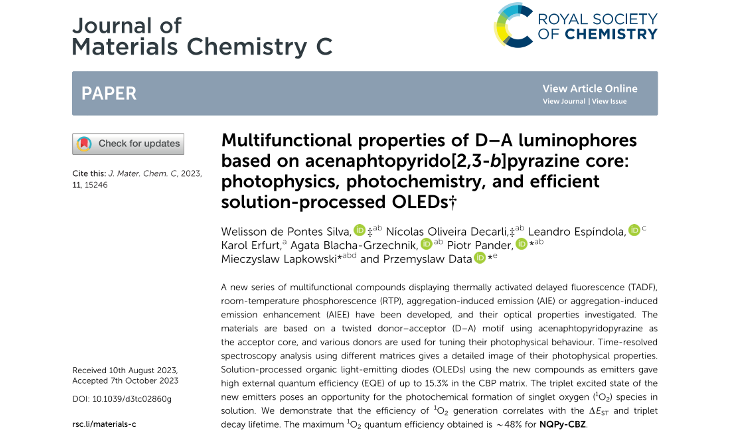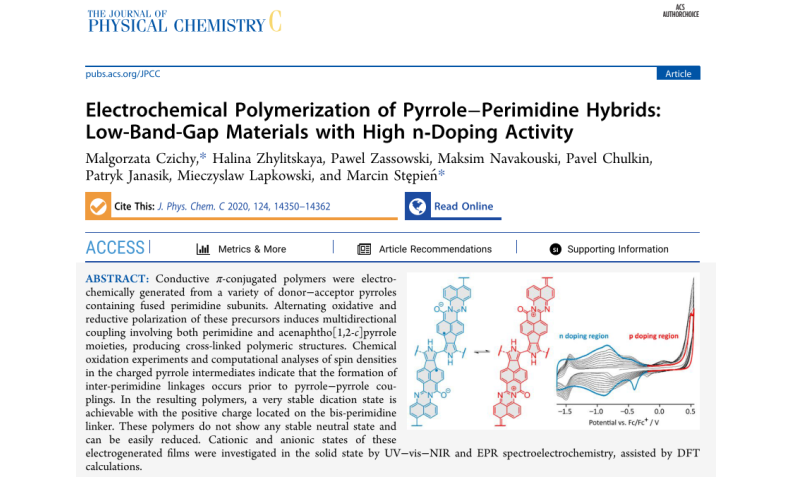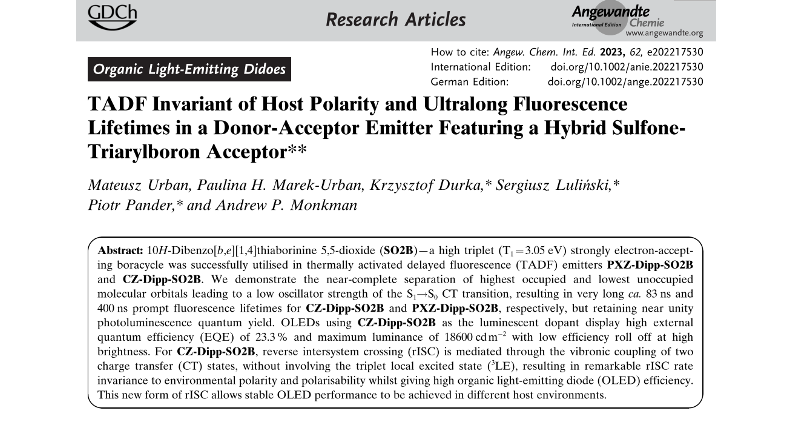Start - Optoelectronics_areas
The team conducts research, among others, on the preparation and characterization of organic compounds exhibiting thermally activated delayed fluorescence (TADF) for use as emitters in organic light-emitting diodes (OLEDs).
Synthesis and characterization of organic electroactive materials

The team conducts research, among others, on the preparation and characterization of organic compounds exhibiting thermally activated delayed fluorescence (TADF) for use as emitters in organic light-emitting diodes (OLEDs).
Selected publications:
- Silva, W. de P. et al. Multifunctional properties of D-A luminophores based on acenaphtopyrido[2,3-b]pyrazine core: photophysics, photochemistry, and efficient solution-processed OLEDs. J. Mater. Chem. C 11, 15246–15260 (2023).
- Ikari, Y. et al. Peripherally Donor-Installed 7,8-Diaza[5]helicenes as a Platform for Helical Luminophores. Synthesis 53, 1584-1596 (2021).
Electrochemistry and spectroelectrochemistry of organic electroactive materials
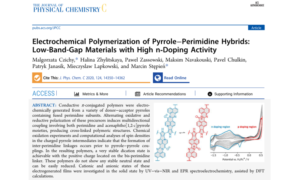
The team specializes in electrochemical and spectroelectrochemical analysis of organic low-molecular compounds as well as oligomers/polymers. The main aim of such analysis is to investigate the properties and suitability of the tested systems for further applications in (opto)electronics, but also to determine and understand the mechanisms of electrode reactions, including degradation processes, and to relate it with the structure of the molecule to enable the design of materials with the desired properties.
Selected publications:
- Ramezankhani, V. et al. High-capacity potassium-ion batteries using new rigid backbone quinone-based polymer electrode materials. Power Sources 562, 1–9 (2023).
- Karoń, K. et al. UV–vis and ECD spectroelectrochemistry of atropisomeric naphthalenediimide derivative. Spectrochim. Acta - Part A Mol. Biomol. Spectrosc. 288, (2023).
- Pluczyk-Malek, S. et al. s-Tetrazine donor-acceptor electrodeposited layer with properties controlled by doping anions generally considered as interchangeable. Electrochim. Acta 405, 139788 (2022).
- Pluczyk-Malek, S., Honisz, D., Akkuratov, A., Troshin, P. & Lapkowski, M. Tuning the electrochemical and optical properties of donor-acceptor D-A2-A1-A2-D derivatives with central benzothiadiazole core by changing the A2 strength. Electrochim. Acta 368, 137540 (2021).
- Czichy, M. et al. Effects of solution-phase ordering on the spectroscopic properties and electrooxidative reactivity of isomeric mixtures and isolated isomers of synthesized amidine derivatives. Dye. Pigment. 178, 108309 (2020).
- Czichy, M. et al. Electrochemical polymerization of pyrrole-perimidine hybrids: Low-Band-Gap materials with high n-doping activity. J. Phys. Chem. C 124, 14350–14362 (2020).
- Pluczyk, S., Higginbotham, H., Data, P., Takeda, Y. & Minakata, S. The impact of replacement of nitrogen with phosphorus atom in the pyromellitic diimides on their photophysical and electrochemical properties. Electrochim. Acta 295, 801–809 (2019).
- Pluczyk, S., Vasylieva, M. & Data, P. Using Cyclic Voltammetry, UV-Vis-NIR, and EPR Spectroelectrochemistry to Analyze Organic Compounds. J. Vis. Exp. e56656 (2018) doi:10.3791/56656.
- Pluczyk, S. et al. Unusual electrochemical properties of the electropolymerized thin layer based on a s-tetrazine-triphenylamine monomer. J. Phys. Chem. C 120, 4382–4391 (2016).
Organic electronics devices
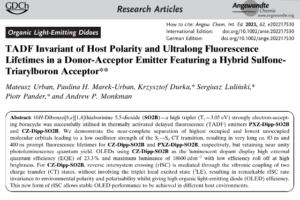
The team is involved in the design and fabrication of prototype organic electronics devices, such as organic light-emitting diodes, organic solar cells and electrochromic windows.
Selected publications:
- Galán-González, A. et al. Nanostructured Channel for Improving Emission Efficiency of Hybrid Light-Emitting Field-Effect Transistors. ACS Photonics (2023) doi:10.1021/acsphotonics.3c01080.
- Salthouse, R. J., Pander, P., Yufit, D. S., Dias, F. B. & Williams, J. A. G. Near-infrared electroluminescence beyond 940 nm in Pt(N^C^N)X complexes: influencing aggregation with the ancillary ligand X. Sci. 13, 13600–13610 (2022).
- Urban, M. et al. TADF Invariant of Host Polarity and Ultralong Fluorescence Lifetimes in a Donor-Acceptor Emitter Featuring a Hybrid Sulfone-Triarylboron Acceptor**. Chemie - Int. Ed. 62, (2023).
- Montanaro, S. et al. Simultaneous enhancement of thermally activated delayed fluorescence and photoluminescence quantum yield via homoconjugation. Mater. Chem. C 10, 6306–6313 (2022).







